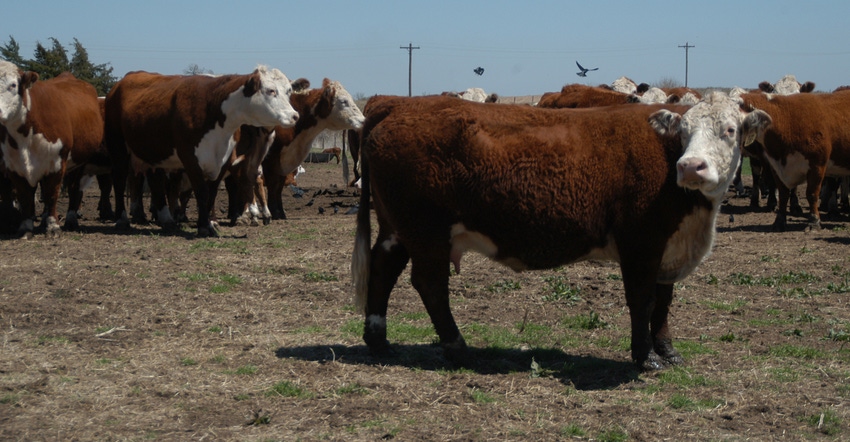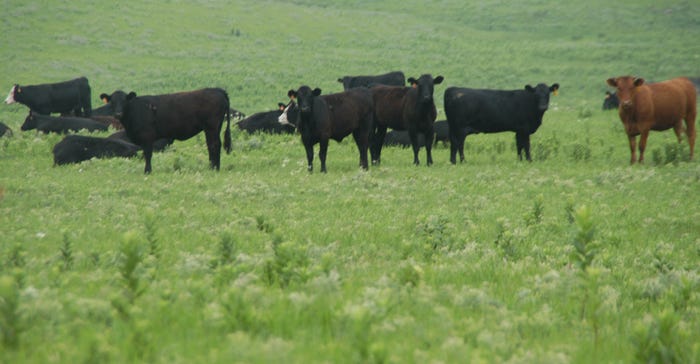Artificial intelligence can track cattle in database by recognizing their faces.

If you see a group of Angus steers at a feed bunk or a group of Hereford cows in a pasture, the average person would say they pretty much look all the same.
However, to an artificial intelligence neural network, each cow face is as unique as a human face and can be recognized anywhere it goes.
Scans of human faces are already being used to positively identify people and allow them to unlock their smartphone or computer, or pass through the security line at the airport.
A team of researchers at Kansas State University has been working since fall of 2019 to bring that technology to the cattle industry by building a database of photos of individual animals that can be used to provide quick traceability of where an animal has been in the event of an animal disease outbreak.
And that is a giant step forward in the effort to limit the duration or damage of an outbreak, according to K.C. Olson, K-State Extension beef specialist.
Olson says the technology is the same as that which identifies people.
“It’s based on facial biometrics,” he says. “But rather than have a human who carefully measures photographs, the neural network teaches itself to recognize which biometrics are critical to recognition and use them to recognize the animal every time a photo is uploaded.”
Olson was part of a team of experts in computer engineering, veterinary medicine and animal science to work on how to apply the technology to cattle.
“Our first effort was to make short videos of about 1,000 feeder cattle that were restrained in a chute,” he says. “We took a panoramic view of each calf’s head. The computer scientists went to work on individual images extracted from the videos and uploaded them to a neural network. From there, the network taught itself what to look for.”
A test of the reliability of the network showed it to be accurate 94% of the time when it came to recognizing cattle in the system and identifying pictures that had not been entered as outside the system, Olson says.
“There’s a tremendous amount of enthusiasm in the industry,” he says. “People are excited about a lot of aspects of this system, but at the top of the list is the privacy this offers while still being able to accurately trace where an individual animal has been.”
Cattle recognition software
He says only two pieces of information are stored at the time the animal is photographed and read into the database: the GPS location of the animal and the date of the photograph. The system also gets an approximate age based on the appearance of the animal in the pictures, so you have the elements of source and age verification. The animals don’t have to be calves; the photo can be collected at any point in the beef marketing chain.
Just as people can grow facial hair, wear a hat or glasses — or even wear a face mask — and recognition technology can still recognize them from their facial biometrics, the neural network can likely recognize the animal photographed as a baby calf when it is a year old steer or a 5-year-old cow, Olson says.
“Another nice thing about this system is that almost every cattle owner already owns a cellphone with a camera, and the app to upload to the database is expected to be free or a very low cost to producers, so the incremental cost is close to zero,” he says.
Unlike RFID tags, which can be lost or broken, the photo in the database can’t be lost, he says. Individual photos also mean that there won’t be cattle missed as they sometimes are if they pass by a tag reader too quickly or move in groups that cause signals from tags to overlap.
The app, called Cattletracs, is being developed by a Kansas City-based company, Black Hereford Holdings, and is expected to be available from a range of app stores by the end of October, and full capability to upload to the system is expected by Thanksgiving, Olson says.
 FOLLOWING MOVEMENT: Most cattle, especially beef cattle, move several times during their lifetime — from the ranch of their birth to a background lot, from background lot to pasture, from pasture to feedyard and finally from feedyard to processing. That makes the ability to trace the trail of animals critical in the event of a disease outbreak. A new system of traceability by facial recognition technology has been developed by a research team at Kansas State University and is being rolled out in the coming months.
FOLLOWING MOVEMENT: Most cattle, especially beef cattle, move several times during their lifetime — from the ranch of their birth to a background lot, from background lot to pasture, from pasture to feedyard and finally from feedyard to processing. That makes the ability to trace the trail of animals critical in the event of a disease outbreak. A new system of traceability by facial recognition technology has been developed by a research team at Kansas State University and is being rolled out in the coming months.

In addition to being easy to use and low cost, the system is secure and private, he says. The information is stored in a cloud-based, block chain-style database that can’t be altered, only added to.
In the event of an animal disease outbreak, the database can be used for rapid traceability, helping to limit the scope of any lockdown of animal movement by pinpointing exactly where the animal has been.
The major limitation is the size of the database. The bigger it grows the smarter the neural network becomes and the higher the accuracy becomes.
Olson says he is hopeful of strong buy-in by cattle owners because the industry brought the idea for it to K-State, and the Kansas Livestock Association is a partner in the effort. However, Olson says participation in the system would be strictly voluntary.
“For producers who don’t want anything to do with a national disease traceability system, that’s fine. Nobody is compelled to participate,” he says. “An animal could be read into the database anytime, such as at the first point of sale after leaving its ranch of origin or any time after that.
“We do know that there can be economic incentives for animals with desired traits, and this system could help with that. But we would potentially get a lot more, including that all-critical element of biosecurity for our industry. The thinking is that this will eventually be applicable to most mammalian livestock species, including hogs and dairy cattle.”
About the Author(s)
You May Also Like



.png?width=300&auto=webp&quality=80&disable=upscale)
.png?width=300&auto=webp&quality=80&disable=upscale)
